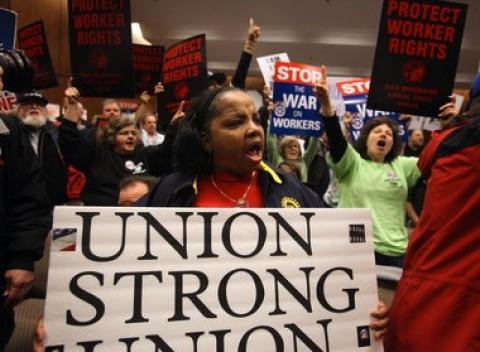The union membership rate--the percent of wage and salary workers who were members of unions--was 10.7 percent in 2016, down 0.4 percentage point from 2015, the U.S. Bureau of Labor Statistics reported today. The number of wage and salary workers belonging to unions, at 14.6 million in 2016, declined by 240,000 from 2015. In 1983, the first year for which comparable union data are available, the union membership rate was 20.1 percent, and there were 17.7 million union workers.
The data on union membership are collected as part of the Current Population Survey (CPS), a monthly sample survey of about 60,000 eligible households that obtains information on employment and unemployment among the nation's civilian noninstitutional population ages 16 and over. For more information, see the Technical Note in this news release.
Highlights from the 2016 data:
--Public-sector workers had a union membership rate (34.4 percent) more than five times higher than that of private-sector workers (6.4 percent). (See table 3.)
--Workers in education, training, and library occupations and in protective service occupations had the highest unionization rates (34.6 percent and 34.5 percent, respectively). (See table 3.)
--Men continued to have a slightly higher union membership rate (11.2 percent) than women (10.2 percent). (See table 1.)
--Black workers were more likely to be union members than were White, Asian, or Hispanic workers. (See table 1.)
--Median weekly earnings of nonunion workers ($802) were 80 percent of earnings for workers who were union members ($1,004). (The comparisons of earnings in this release are on a broad level and do not control for many factors that can be important in explaining earnings differences.) (See table 2.)
--Among states, New York continued to have the highest union membership rate (23.6 percent), while South Carolina continued to have the lowest (1.6 percent). (See table 5.)
Industry and Occupation of Union Members
In 2016, 7.1 million employees in the public sector belonged to a union, compared with 7.4 million workers in the private sector. The union membership rate for public-sector workers (34.4 percent) was substantially higher than the rate for private-sector workers (6.4 percent). Within the public sector, the union membership rate was highest for local government (40.3 percent), which includes employees in heavily unionized occupations, such as teachers, police officers, and firefighters. In the private sector, industries with high unionization rates included utilities (21.5 percent), transportation and warehousing (18.4 percent), telecommunications (14.6 percent), construction (13.9 percent), and educational services (12.3 percent). Low unionization rates occurred in finance (1.2 percent), agriculture and related industries (1.3 percent), food services and drinking places (1.6 percent), and professional and technical services (1.6 percent). (See table 3.)
Among occupational groups, the highest unionization rates in 2016 were in education, training, and library occupations (34.6 percent) and in protective service occupations (34.5 percent). The lowest unionization rates were in farming, fishing, and forestry occupations (2.2 percent); sales and related occupations (3.1 percent); computer and mathematical occupations (3.9 percent); and food preparation and serving related occupations (3.9 percent).
Selected Characteristics of Union Members
In 2016, the union membership rate continued to be slightly higher for men (11.2 percent) than for women (10.2 percent). (See table 1.) The gap between their rates has narrowed considerably since 1983 (the earliest year for which comparable data are available), when rates for men and women were 24.7 percent and 14.6 percent, respectively.
Among major race and ethnicity groups, Black workers continued to have a higher union membership rate in 2016 (13.0 percent) than workers who were White (10.5 percent), Asian (9.0 percent), or Hispanic (8.8 percent).
By age, union membership rates continued to be highest among workers ages 45 to 64. In 2016, 13.3 percent of workers ages 45 to 54 and ages 55 to 64 were union members.
The union membership rate was 11.8 percent for full-time workers, more than twice the rate for part-time workers at 5.7 percent.
Union Representation
In 2016, 16.3 million wage and salary workers were represented by a union. This group includes both union members (14.6 million) and workers who report no union affiliation but whose jobs are covered by a union contract (1.7 million). (See table 1.)
Earnings
Among full-time wage and salary workers, union members had median usual weekly earnings of $1,004 in 2016, while those who were not union members had median weekly earnings of $802. In addition to coverage by a collective bargaining agreement, this earnings difference reflects a variety of influences, including variations in the distributions of union members and nonunion employees by occupation, industry, age, firm size, or geographic region. (See tables 2 and 4.)
Union Membership by State
In 2016, 27 states and the District of Columbia had union membership rates below that of the U.S. average, 10.7 percent, while 23 states had rates above it. All states in the West South Central division had union membership rates below the national average, and all states in both the Middle Atlantic and the Pacific divisions had rates above it. Union membership rates decreased over the year in 31 states and the District of Columbia, increased in 16 states, and were unchanged in 3 states. (See table 5.)
Nine states had union membership rates below 5.0 percent in 2016, with South Carolina having the lowest rate (1.6 percent). The next lowest rates were in North Carolina (3.0 percent), Arkansas (3.9 percent), and Georgia (3.9 percent). New York was the only state with a union membership rate over 20.0 percent in 2016 at 23.6 percent.
State union membership levels depend on both the employment level and the union membership rate. The largest numbers of union members lived in California (2.6 million) and New York (1.9 million). Over half of the 14.6 million union members in the U.S. lived in just 7 states (California, 2.6 million; New York, 1.9 million; Illinois, 0.8 million; Pennsylvania, 0.7 million; and Michigan, New Jersey, and Ohio, 0.6 million each), though these states accounted for only about one-third of wage and salary employment nationally.


Spread the word